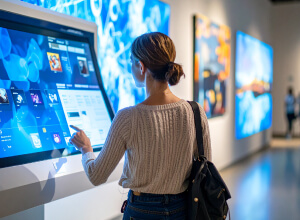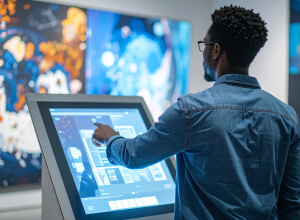Interactive Museum Displays, Exhibits & Technology

Interactive displays have shown to be the easiest way for modern museums to attract more visitors, so it’s no surprise that more and more are investing in upgraded interactive museum technology.
How Do You Make a Museum Exhibit Interactive?
Museums are increasingly incorporating interactive displays into their exhibits. Interactive displays provide a hands-on approach to learning and can be used to build an immersive experience for visitors. By connecting physical objects with digital content, museums can create engaging experiences that keep people coming back. We put together a list of examples of the types of interactive technology museums use to engage visitors better.
Interactive Museum Kiosk & Display Examples
One simple way to make an exhibit interactive is by using touch-based kiosks and displays. Here are some examples of how you can use interactive kiosks and displays in a museum or exhibit:
Interactive Museum Maps
Interactive museum maps can be used to engage visitors in a way that traditional paper maps are not capable of. Interactive maps or wayfinding enable visitors to learn more about the museum’s exhibits, get directions around galleries, and plan their visit. Interactive kiosks can also provide additional information about the exhibits and collections.

Museum Display & Exhibits with Interactive Learning
Museums can use interactive displays to create more engaging and immersive learning experiences for their visitors. Touchscreens and interactive kiosks provide a unique opportunity for visitors to learn about the artwork or artifacts on display in depth rather than merely admiring them from afar. These interactive displays can provide videos, 3D models, audio files, and games that permit visitors to deeply explore the exhibit, understanding its detail and significance through more active engagement. This encourages people to connect with the art pieces and artifacts on an emotional level, creating a memorable experience that they won't soon forget.

Games for touchscreen displays
Games can be used in museums to create interactive experiences and give visitors a deeper understanding of the artwork or historical artifacts on display. For example, visitors could take virtual tours of different parts of the museum, put together puzzles recreating famous works of art for a challenge, take quizzes, or solve puzzles related to the exhibits they're viewing.
Visitor Check-In & Registration Kiosks
Museums use interactive kiosks to provide an easy way for visitors to check in or register for events and activities. Such interactive kiosks provide guests with a self-serve option to research options and easily book their tickets.
If you're looking for inspirational use cases for touch screens in your museum, click here to discover amazing examples.
Other types of interactive technology for museums
Touchscreens are not the only way to bring interactivity to your museum or exhibit. Here are some modern technologies that can be used.
Projection Mapping for museums and exhibits
Projection mapping is an incredibly modern technology that will surely generate a tremendous reaction, creating an immersive and unforgettable experience. Projection mapping is the practice of projecting images onto a surface using projectors, creating the illusion that your physical objects are coming alive. Museums can use projection mapping in coordination with interactive displays to bring their exhibits to life and engage visitors with stories and historical events.
The Van Gogh Exhibition is a captivating projection mapping example that is touring the globe, showcasing its incredible power to bring artworks to life and elicit deep emotions from viewers. This interactive display brilliantly illustrates how technology can be used in innovative ways!
Virtual Reality in interactive exhibits
Virtual reality (VR) technology can be used in museums to reinforce learning objectives and provide visitors with an unforgettable experience. Thanks to the power of Virtual Reality, museum visitors can immerse themselves in various worlds - all without having to leave the building! Whether viewing ancient artifacts or participating in simulations that would otherwise be impossible, VR gives explorers an unparalleled way to immerse themselves and gain new insight.
A great example of VR in action is ‘Mona Lisa: Beyond the Glass’, a VR experience launched by the Paris Louvre that explores Renaissance painting as part of its Leonardo da Vinci blockbuster exhibition.
Sensors, RFID tags, Computer Vision and More
RFID tagging and sensors, in general, can be used in museums to create interactive experiences for visitors. For example, sensors could be placed around artifacts to trigger audio or video playback when someone gets close to them. RFID tags can be attached to objects by curators so that they can track where the items are located at any time. Additionally, sensors and RFID can be used to help those with disabilities better engage with museum exhibits by providing audio descriptions or tactile feedback.
Head to our Interactivity - Beyond Touch page to read more about these interactions.
These are just some of the ways museums use interactive technology to create engaging experiences for their visitors. Interactive museum technology is an excellent way for museums to draw in more people and keep them engaged during their visits. With ever-evolving new technologies, there’s no telling what kinds of innovative interactive museum displays will come next!
Explore Intuiface, the leading museum interactive kiosk software on the market today! Developed with innovation and ease of use in mind, it offers a powerful platform for creating immersive experiences that engage users and keep them coming back.





